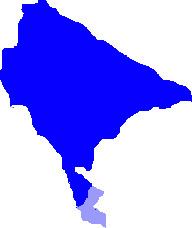 | ||
This article presents the demographic history of Montenegro through census results and official documents which mention demographic composition. See Demographics of Montenegro for a more detailed overview of the current demographics of Montenegro.
Contents
Medieval
Duklja, today's southern half of Montenegro, under Stefan Vojislav, was inhabited by Serbs.
Various documents listed that the inhabitants of Medieval Doclea or Zeta were Serbs, but also minor populations of Latins, Albanians and Vlachs. The language in usage was primarily the Old Slavonic, while in the early stages Latin also had importance and Greek to an extent among the high-class members of the society.
Between the 15th and 17th century, Montenegro had little history on paper. During these years, hundreds of families of Montenegrins moved to Rascia which Serbs left to sought refuge in Habsburg Monarchy.
1614
Mariano Bolizza of Kotor was a public servant of the Republic of Venice. The main objective of his 1614 report and description of the Sanjak of Shkodra was to provide information on the land routes which could best be utilized by local couriers conveying official correspondence from Venice to Constantinople and back, and to survey the military potential of the territory. He provided a very detailed overview of towns and villages in Montenegro and northern Albania in the early 17th century. The report concluded an ethnic Montenegrin majority, while an Albanian minority was present in the Shkodra region.
18th century
The ethnic composition in the 18th century was clear among the Slavs;
19th century
1900
In 1900, according to international sources, the Principality of Montenegro had 311,564 inhabitants. By religion:
By literacy:
The Princedom had around 5,000 Albanians and a colony of 800 Romani.
1905
This year there were 6,674 emigrants, mostly to the United States.
1906
This year there were 4,346 emigrants, mostly to the United States.
1907
It has been estimated that there were around 282,000 inhabitants in Montenegro this year.
1909
The 1909 official census was undertaken by the authorities of the Principality of Montenegro. Ethnicity was decided according to the mother tongue and religion, the official language being the Serbian language:
Total: 317,856 inhabitants. By language:
By religion:
1911
In 1911, the population of Montenegro had risen to 211,909.
In a geographic textbook for Montenegrin 3rd graders of elementary school, it was written that:
"In Montenegro live only true and pure Serbs who speak Serbian language... Besides Montenegro there are more Serb lands in which our Serb brothers are living... Some of them are free as we are and some subjugated to foreigners[...] Each Serb in Montenegro is obligated to love his entire Fatherland, all Serb lands - in which our free and unfree Serb brothers are living."
1914
The Cetinje government stated in the Code of Law in 1914 that there are around 500,000 citizens of Montenegro. It was declared that the term Montenegrin people can only refer to all citizens of the Kingdom of Montenegro, since a Montenegrin ethnicity doesn't exist and Montenegrins were seen as ethnic Serbs.
1921
In 1918 Montenegro entered the Kingdom of Serbs, Croats and Slovenes. In 1921 it organised a census which recorded the mother tongue and religion. A category called Serbian or Croatian was to include all respondents who termed their mother tongue as Serbian. In the counties Andrijevica, Bar, Kolasin, Niksic, Podgorica and Cetinje, which are categorized in official statistics as Montenegro, there were:
Total: 199,227 inhabitants
The counties Berane and Bijelo Polje, which are today in Montenegro, were considered counties of Old Serbia:
Summed results:
Total: 249,238 inhabitants
Total population for the area of modern-day Montenegro in precise was 311,341.
1931
The 1931 census was also taken by the Kingdom of Yugoslavia but was later processed in Communist Yugoslavia. Results within today's borders of Montenegro were:
1948
In 1945, after the World War II, Communist Yugoslavia was formed, and Montenegro was proclaimed as one of its constituent republics. The 1948 and following censa were taken by the Republic of Montenegro.
1953
This census witnesses the forming of the Yugoslav nation.
1961
The 1961 census results:
In 1968 the Communist Yugoslav government introduced a new category, Muslims by nationality.
1981
The 1981 census results:
Total: 584,310 inhabitants:Montenegrins: 400,488 (68.54%):Muslims: 78,080 (13.36%):Albanians: 37,735 (6.46%):Yugoslavs: 31,243 (5.35%):Serbs: 19,407 (3.32%):Croats: 6,904 (1.81%):Roma: 1,471 (0.25%):Macedonian: 875 (0.15%):Slovenes: 564 (0.1%):Hungarians: 238 (0.04%):Germans: 107 (0.02%):Russians: 96 (0.02%):Italians: 45 (0.01%):Other: 816 (0.14%):No response: 301 (0.05%):Regional affiliation: 1,602 (0.27%):Unknown: 4,338 (0.74%)1991
The 1991 census results:
Total: 615,035 inhabitants
Ethnic structure
:Montenegrins: 380,467 (61.86%):Muslims: 89,614 (14.57%):Serbs: 57,453 (9.34%):Albanians: 40,415 (6.57%):Yugoslavs: 26,159 (4.25%):Croats: 6,244 (1.02%):Roma: 3,282 (0.53%):Macedonian: 1,072 (0.17%):Slovenes: 369 (0.06%):Hungarians: 205 (0.03%):Germans: 124 (0.02%):Russians: 118 (0.02%):Italians: 58 (0.01%):Other: 437 (0.07%):No response: 1,944 (0.32%):Regional affiliation: 998 (0.16%):Unknown: 6,076 (0.99%)Linguistic structure
Religious structure
2003
The 2003 census was undertaken by authorities in Montenegro, which at this time, together with Serbia, constituted Serbia and Montenegro.
Total: 620,145
Ethnic structure
This census witnessed the forming of the Bosniak nation, but some people still thought of themselves Muslims by nationality, however. Also, there are very few people left who consider themselves Yugoslavs. But the biggest difference compared to the 1991 census is the dramatic increase in self-identification of many inhabitants as Serbs, which was not the case in Socialist Yugoslavia.
Linguistic structure
2011
Total: 620,029
